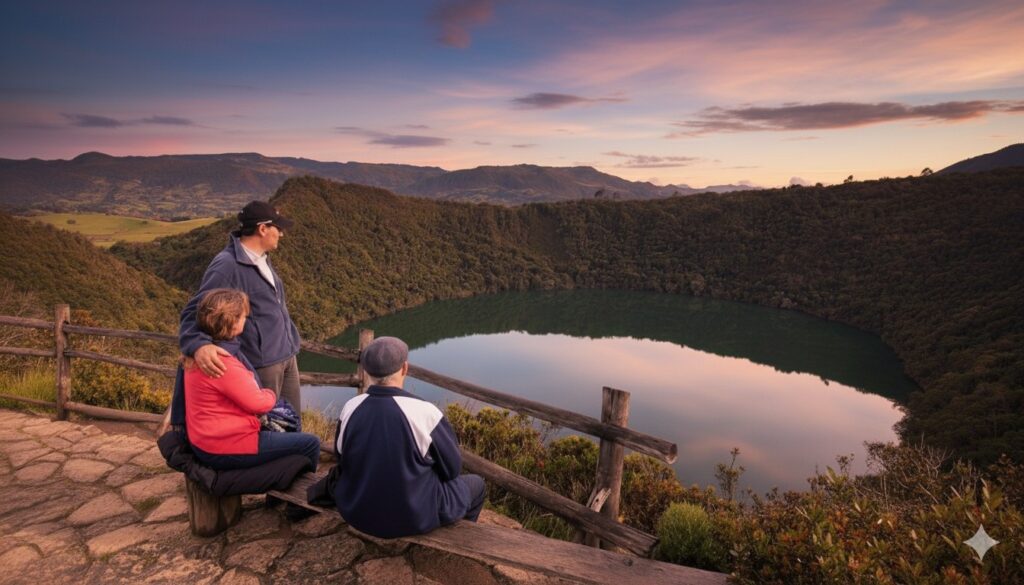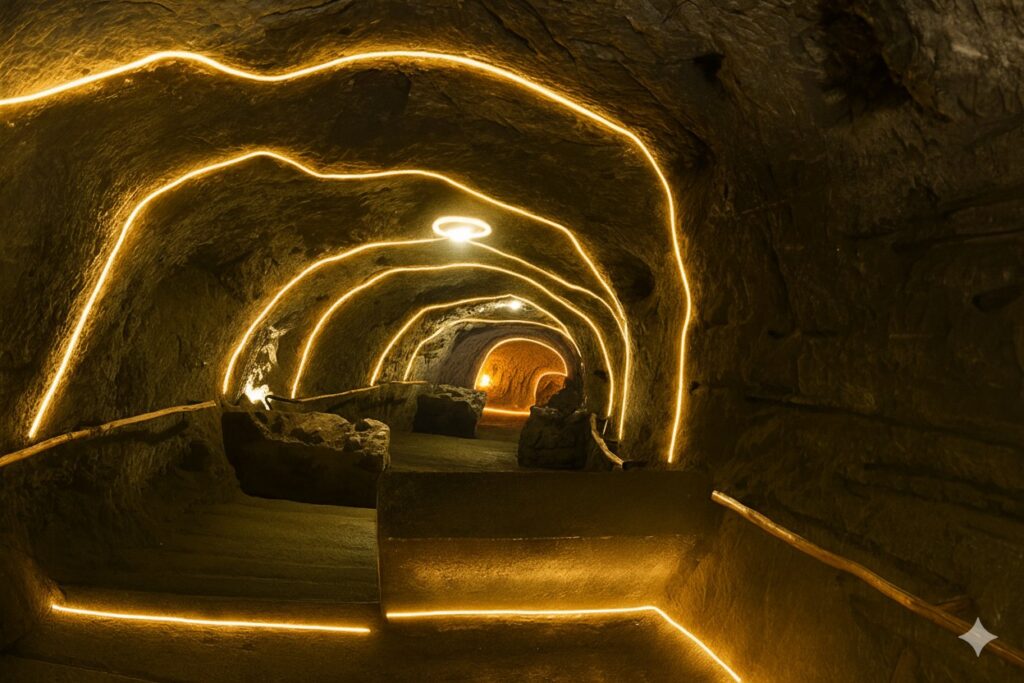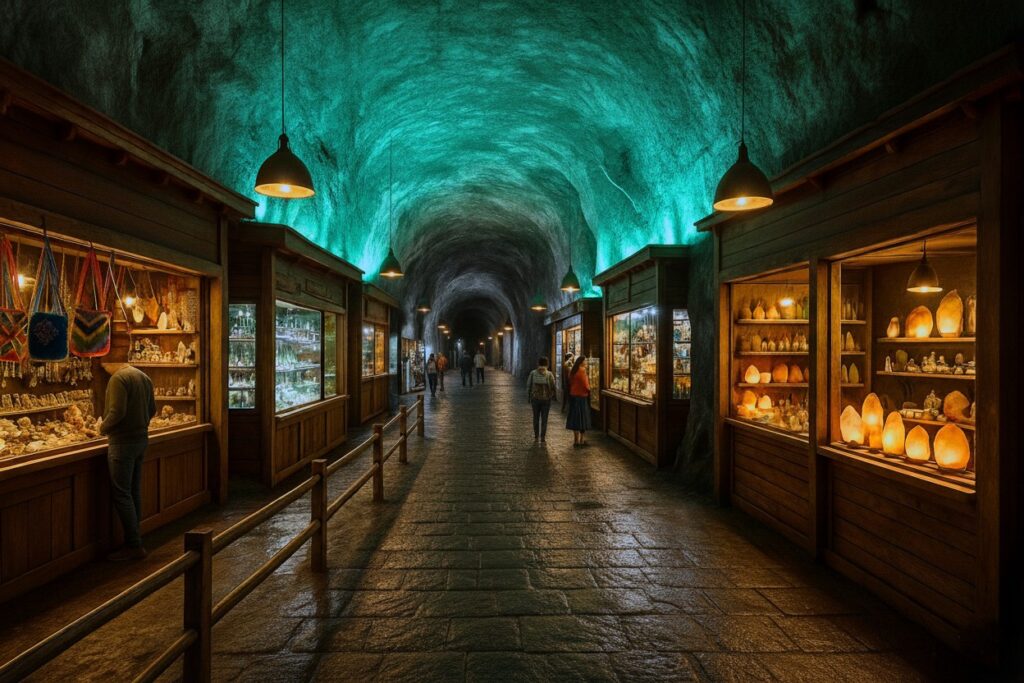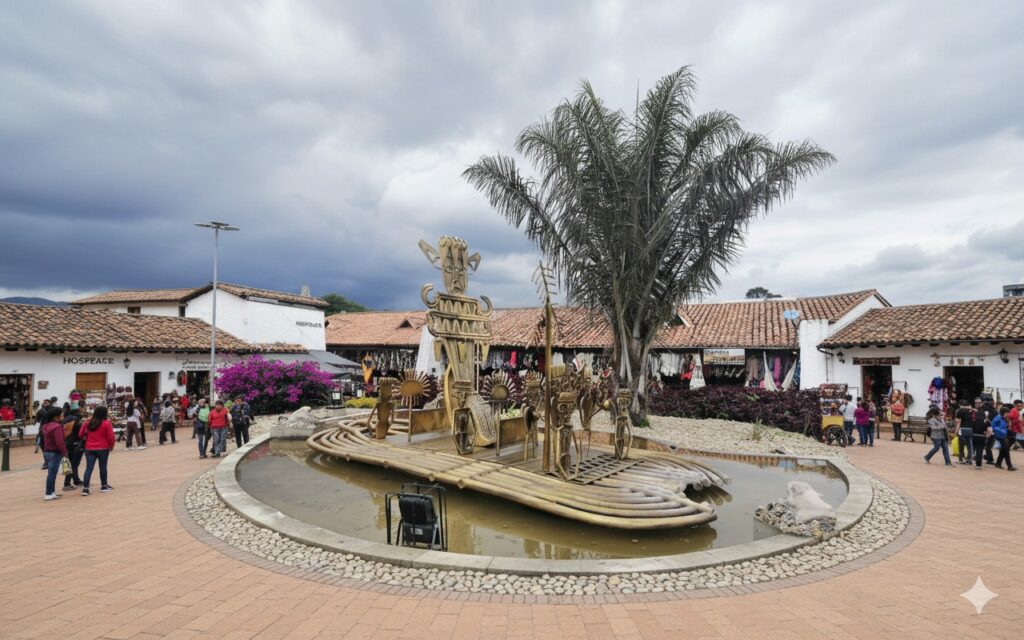October 5, 2025
Worlds Below the Surface
When we think of Bogotá’s surroundings, towering mountains, colorful towns, and lush landscapes often come to mind. Among the most extraordinary experiences are two destinations that couldn’t be more different yet complement each other perfectly: the world-famous Salt Cathedral of Zipaquirá, carved deep underground into an old salt mine, and the emerald-green lagoon of Guatavita where El Dorado legend still lays.
Just an hour’s drive north of the capital, the journey begins with a comfortable private drive out of Bogot. Rolling green hills, traditional farms, and scattered small towns will lead first into Zipaquirá, where its colonial rooftops hint at the history to be uncovered — before the day later expands into the quiet beauty and mythical aura of Guatavita.
Like what you’re hearing? Book your private tour now here!
The Colonial Gateway
Location: Zipaquirá & Guatavita Town, Cundinamarca

Guatavita Lagoon
Before venturing underground, we arrived in Zipaquirá itself — a charming colonial town often overshadowed by its famous cathedral but worthy of exploration in its own right. The central Plaza de los Comuneros is framed by pastel-toned façades, baroque churches, and lively cafés where locals gather throughout the day.
Wandering its cobblestoned streets, we felt the town’s mining heritage and slow rhythm. It was here that our guide introduced us to the story of salt in Colombia — how it shaped trade routes, economies, and culture long before the cathedral was conceived. Zipaquirá has been a salt capital for centuries, and its very name comes from the indigenous word for “land of abundance.”
The town is not simply a waiting room for the cathedral; it’s alive with traditions. Vendors sell fresh arepas and obleas near the plaza, schoolchildren run across the square, and colonial-era buildings hold echoes of the independence era. Taking this walk before the descent grounded us in the community that gave rise to the cathedral and reminded us that the salt mine is part of a larger cultural tapestry.
Later in the day, our journey led us to Guatavita town, a place as picturesque as the lagoon it neighbors. Tucked between emerald hills and crowned with whitewashed houses and terracotta roofs, Guatavita feels like a storybook village. Its streets are quieter than Zipaquirá’s, with artisan shops, handicraft stalls, and cafés that look out over the surrounding mountains. The town was rebuilt in the 1960s after the original was submerged by the creation of the Tominé Reservoir, giving it a planned yet charming layout with tiled plazas and flowered balconies.
Walking its streets felt like stepping into a living postcard. Local artisans sold wool textiles, pottery, and carved wooden figures, while small restaurants served hearty soups perfect for the cool mountain climate. Visiting Guatavita town before or after the lagoon gave context to the legend of El Dorado, showing how modern communities preserve traditions while embracing visitors eager to understand their past.
Descending into the Salt Cathedral

Descent into Salt Mine
Walking into the salt mine is an experience that builds suspense. The cool air greets you as you step into dimly lit tunnels glowing with shades of blue and violet. The further we descended, the quieter it became — not silent, but reverberating, as if the earth itself were holding its breath.
Inside, the Salt Cathedral reveals itself gradually. Each chamber is carved directly into walls of mineral rock, a blend of human craftsmanship and nature’s raw textures. Along the way, chapels representing the Stations of the Cross appear, each marked by sculptures, crosses, and reliefs carved into salt.
Even if you aren’t religious, the artistry is staggering. Light installations add a theatrical atmosphere, casting shadows that make the salt walls glow. You feel as though you’re inside a massive art installation as much as a sacred space. Every step leads you deeper into contemplation, and the physical act of walking through the tunnels feels symbolic of a journey into the soul.
The Main Nave: Awe in Every Sense
The highlight for us — and for every visitor — is the main nave. Stepping into the cavernous chamber, we were greeted by a monumental illuminated cross, its reflection glowing on the polished salt floor. The sheer scale is humbling. Looking upward, the vaulted ceiling feels infinite, a reminder that this cathedral sits nearly 200 meters underground.
What struck us most was the acoustics. Even a whisper seemed to carry, and when a guide sang a short note to demonstrate, the sound reverberated like a cathedral made of crystal. It’s no surprise that concerts and masses here are considered unforgettable.
It’s here where many visitors pause the longest. Some sit on the benches in quiet reflection, others take photos, and a few simply stand still, looking up at the illuminated cross. For us, it was a moment of stillness, an encounter with a space that is both human-made and profoundly natural.

Commercial venue at Zipaquira’s Salt Mine
A Guide’s Touch: History and Meaning
Having a private guide transformed the experience. Rather than just admiring the architecture, we learned the story behind it: how Colombian miners carved the first chapel as a sanctuary to pray before descending into dangerous work, and how this spiritual impulse evolved into one of the most iconic monuments in Latin America.
The guide pointed out symbolic details — the way light falls on certain crosses, the cultural motifs etched into salt, and the geological wonders of the mineral walls. He tied these observations to Colombian traditions, religious heritage, and even the country’s mining economy.
He also shared the cathedral’s modern history: the original chapel built in the 1930s that became unsafe, and the larger, current cathedral inaugurated in 1995. The decision to create such a monumental structure underground was bold, but it reflected both faith and pride in Colombia’s natural resources.
Beyond the Cathedral: Zipaquirá’s Cultural Soul
After resurfacing, we wandered Zipaquirá’s historic streets with new eyes. The mining legacy now felt alive in the architecture and everyday life. On the Plaza de los Comuneros, we stopped to admire the main cathedral and colonial arches, imagining the centuries of history they’ve witnessed.
For lunch, our guide recommended a local restaurant specializing in regional dishes. We enjoyed steaming bowls of ajiaco — Bogotá’s iconic chicken and potato soup — and bandeja boyacense, a hearty platter from the neighboring department. Sharing these meals in a traditional setting felt like a perfect continuation of the underground journey: one that connected body and soul.
Even small details enriched the afternoon: hearing local musicians play in the square, tasting fresh chicha (a traditional fermented corn drink), and observing artisans selling salt-carved crafts. The entire town seemed to echo the theme of the cathedral — transformation of the everyday into something extraordinary.
Journey to Guatavita Lagoon

Plaza at Guatavita
The day continued with a scenic drive deeper into the highlands of Cundinamarca, toward the fabled Laguna de Guatavita. Unlike the cathedral, which pulls you underground, the lagoon draws your gaze skyward and outward, into Colombia’s natural and mythological heritage.
The road winds through rolling farmland and dense forests before reaching the quiet town of Sesquilé. From there, a short uphill hike takes you to the rim of the emerald lagoon, nestled in a volcanic crater surrounded by páramo vegetation. The air here is cooler, thinner, and filled with the scent of wild herbs.
Standing on the edge, we were struck by the mirror-like water, shimmering in shades of green and gold depending on the light. It’s no wonder this site gave birth to the legend of El Dorado, where indigenous Muisca chiefs are said to have offered gold to the gods by casting treasures into the depths.
Myths, Nature, and Silence
At Guatavita, history blends seamlessly with myth. Our guide recounted how the Muisca people used the lagoon for sacred rituals, painting themselves in gold dust before diving into the water. Archaeological evidence supports the stories, with golden artifacts recovered from the area over centuries.
But beyond the myth, Guatavita is profoundly peaceful. The trail around its rim offers changing perspectives of the lagoon and the surrounding hills. Birds dart across the water, the wind whispers through frailejones, and the stillness of the place invites reflection.
Unlike the grandeur of Zipaquirá, Guatavita’s magic is understated — its power lies in silence, vastness, and its connection to ancient ritual. Experiencing both in one day created a balance: man-made wonder beneath the earth and timeless natural beauty under the open sky.
Comfort and Exclusivity
Having a private tour meant moving seamlessly between two very different worlds. The drive between Zipaquirá and Guatavita was comfortable, with time to rest, enjoy the views, and listen to stories from our guide about the Muisca, Spanish conquest, and modern Colombia.
We didn’t have to worry about logistics, parking, or timing. Instead, we enjoyed every moment, from sipping coffee in Zipaquirá to walking the forested paths above Guatavita. For travelers seeking a day trip that balances comfort with discovery, this pairing of destinations is one of the best near Bogotá.
Don’t miss the chance to see this underground wonder. Reserve your Salt Cathedral tour today.
Practical Tips for Visitors
- Book a private tour: Combining Zipaquirá and Guatavita in one day requires good timing — a private guide makes it smooth and flexible.
- Wear layers: The cathedral is cool underground, and Guatavita’s páramo climate can be chilly and windy.
- Good walking shoes: Guatavita’s trails include inclines and natural steps.
- Hydrate and pace yourself: The lagoon sits over 3,000 meters above sea level, so take it easy on the hike.
- Savor the contrast: Enjoy the interplay of underground art and open-air myth. Few places offer such different perspectives in a single day.
Two Wonders, One Journey
Visiting both the Zipaquirá Salt Cathedral and the Guatavita Lagoon in a single day offered one of the most complete experiences we’ve had near Bogotá. Together, they capture the essence of Colombia: a land where nature, history, art, and myth intertwine.
The cathedral moves you with its human-made devotion carved into salt; the lagoon reminds you of nature’s power and the mysteries that endure through centuries. Experiencing both left us with a sense of wonder — at Colombia’s creativity, spirituality, and landscapes.
Meet the Team
We’re creators, marketers, and explorers — united by our love for Colombia and passion for storytelling. From content creators and strategists to social media experts and tour managers, we bring your journey — or your brand — to life.
CEO & Founder
Shawn Christopher Leamon
Read More
Social Media Director
Daniel Cardenas
Read More
Operations
Camilo Ceballos
Read More
Graphic Designer
Juan Sierra
Read More
Sales Manager
Juliana Gama
Read More
Social Media Specialist
Dayana Parra
Read More
Sales
Fabian Briñez
Read More
Sales
Johanna Vargas
Read More
Content & Multimedia Strategist
Diana Bustos
Read More
Visual Content Creator
Gabriela Munoz
Read More
Marketing Tours & Content Manager
Sergio Gonzalez
Read More
Storytelling Specialist
Brian Nino
Read More
Finance & Strategy Lead
Fernando Soto
Read More
CEO & Founder
Shawn Christopher Leamon
Read More
Social Media Director
Daniel Cardenas
Read More
Operations
Camilo Ceballos
Read More
Graphic Designer
Juan Sierra
Read More
Sales Manager
Juliana Gama
Read More
Social Media Specialist
Dayana Parra
Read More
Sales
Fabian Briñez
Read More
Sales
Johanna Vargas
Read More
Content & Multimedia Strategist
Diana Bustos
Read More
Visual Content Creator
Gabriela Munoz
Read More
Marketing Tours & Content Manager
Sergio Gonzalez
Read More
Storytelling Specialist
Brian Nino
Read More
Finance & Strategy Lead
Fernando Soto
Read More
